Bryan L. Programmable controllers. Theory and implementation
Подождите немного. Документ загружается.

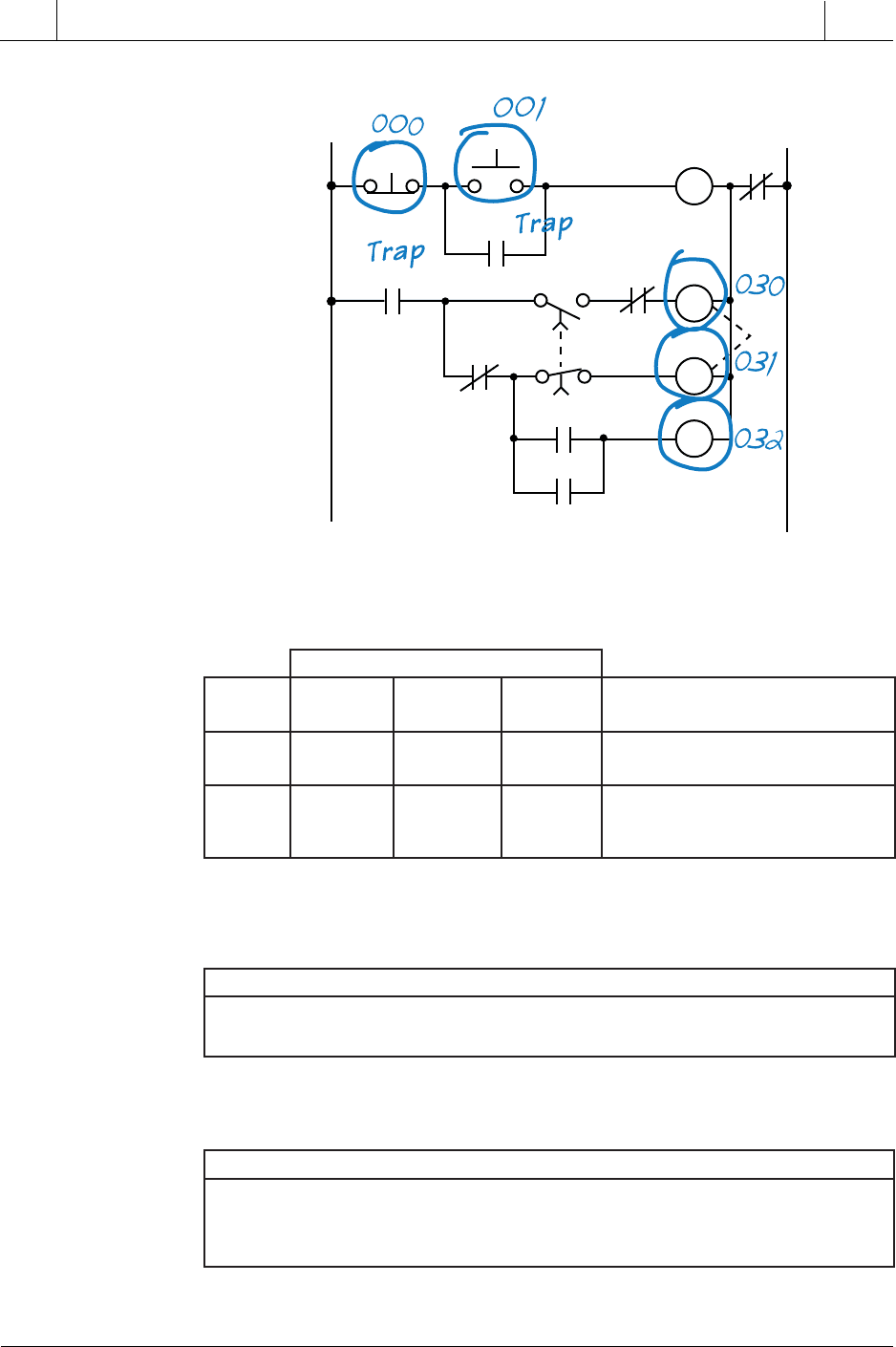
479
CHAPTER
11
System Programming
and Implementation
Industrial Text & Video Company 1-800-752-8398
www.industrialtext.com
SECTION
3
PLC
Programming
Table 11-13. I/O address assignment.
Table 11-14. Internal address assignment.
Table 11-15. Register assignment.
Figure 11-37. Real inputs and outputs to the PLC.
sserddAO/I
eludoM
epyT kcaR puorG lanimreT noitpircseD
tupnI 0 0 0 )CN(BPpotS
0 0 1 )ON(BPtratS
tuptuO 0 3 0 1MretratSrotoM
0 3 1 1S
0 3 2 2S
Stop
Start
OL
L1 L2
TR1
TR1
S1
S1
TR1
TR1
TR1
S2
S2
S1
M1
M1
1
2
3
4
5
6
retsigeR noitpircseD
0004 3.5rofces1.0esabemit,35eulavretsigerteserP
)1001situptuoremit(ces
1004 1001tuptuoremitrofretsigerdetalumuccA
eciveDlanretnInoitpircseD
—0001tiucricremitparT
remiT1001remiT
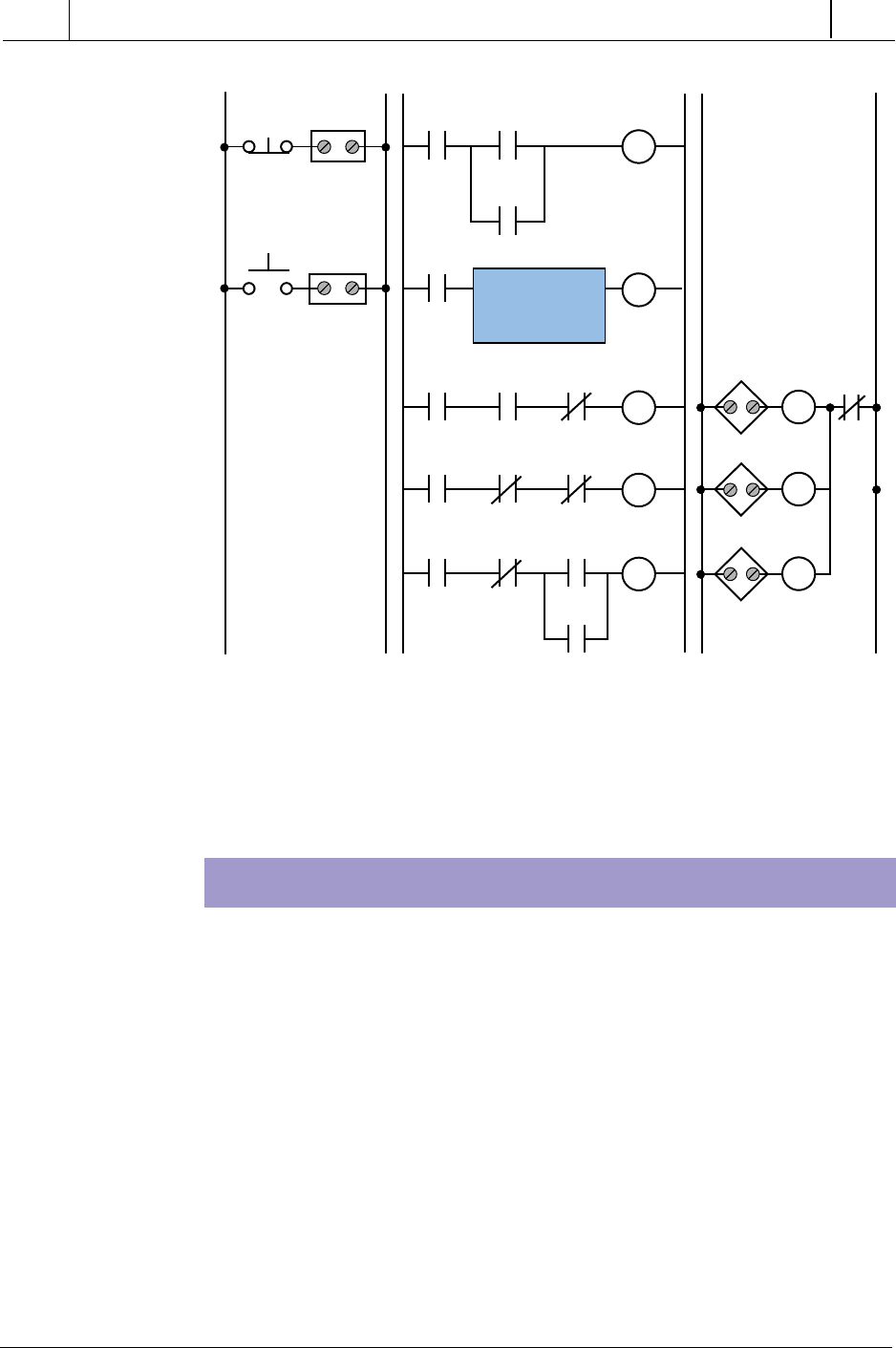
480
SECTION
3
PLC
Programming
Industrial Text & Video Company 1-800-752-8398
www.industrialtext.com
CHAPTER
11
System Programming
and Implementation
grammed as normally open (closed when the overloads are closed and the
motor is running) and placed in series with contact 1000 in line 3 of the PLC
program. If the overloads open, the circuit will lose continuity and M1 will
turn OFF.
Figure 11-38. PLC implementation of the circuit in Figure 11-36.
AC MOTOR DRIVE INTERFACE
A common PLC application is the speed control of AC motors with variable
speed (VS) drives. The diagram in Figure 11-39 shows an operator station
used to manually control a VS drive. The programmable controller imple-
mentation of this station will provide automatic motor speed control through
an analog interface by varying the analog output voltage (0 to 10 VDC) to the
drive.
The operator station consists of a speed potentiometer (speed regulator), a
forward/reverse direction selector, a run/jog switch, and start and stop push
buttons. The PLC program will contain all of these inputs except the
potentiometer, which will be replaced by an analog output. The required input
field devices (i.e., start push button, stop push button, jog/run, and forward/
reverse) will be added to the application and connected to input modules,
rather than using the operator station’s components. The PLC program will
contain the logic to start, stop, and interlock the forward/reverse commands.
L2
L1 L1
L2
030
001
000
Start
Stop
M1 OL
031
S1
032
S2
Trap
1000
Trap
1000
Start
001
Stop
000
S2
032
Trap
1000
S1
031
M1
030
TMR
1001
Trap
1000
TMR
1001
S1
031
M1
030
Trap
1000
PR: 4000 = 53
AR: 4001
TB = 0.1
TMR
S1
031
S2
032
M1
030
Trap
1000
TMR
1001
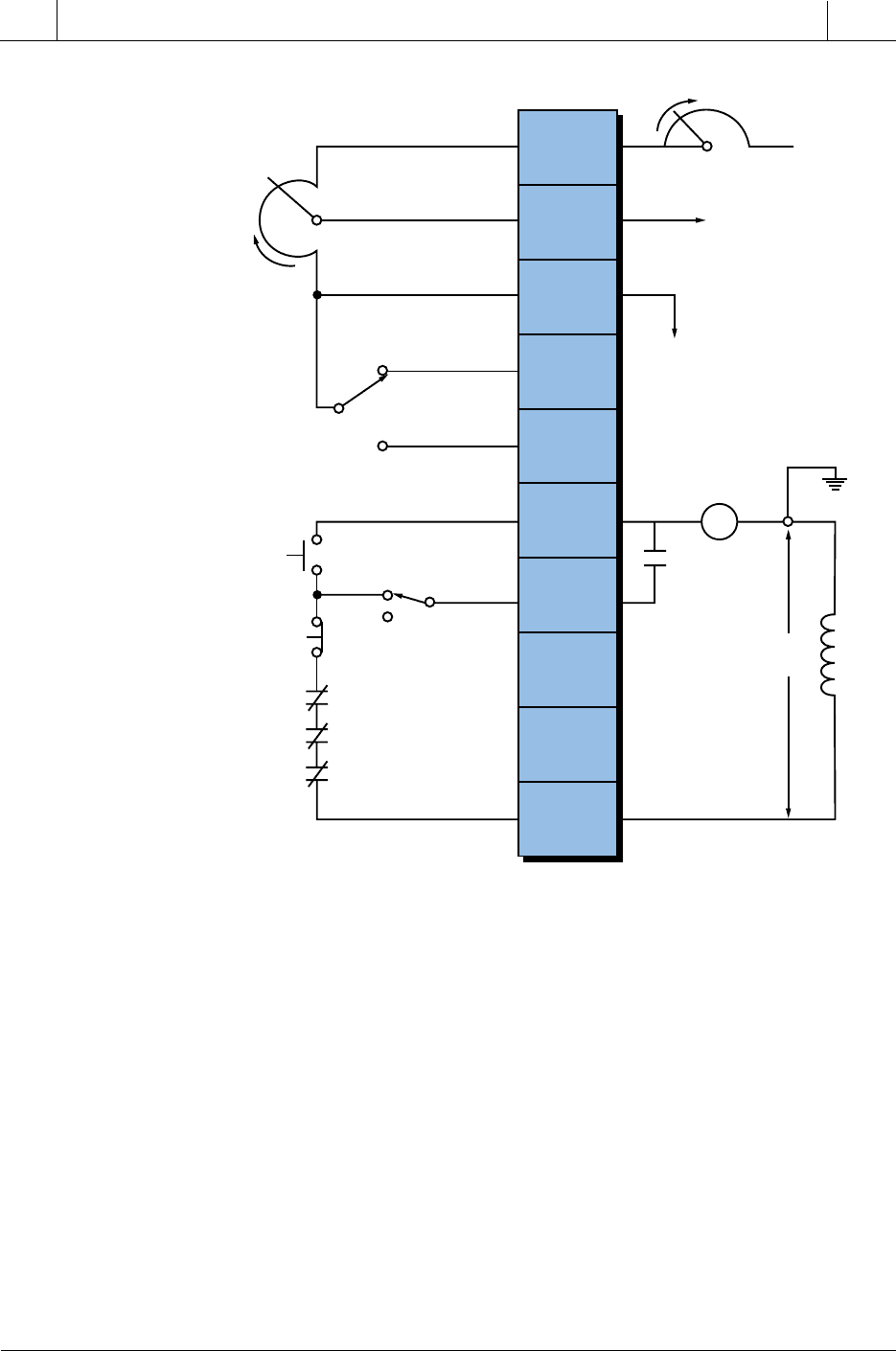
481
CHAPTER
11
System Programming
and Implementation
Industrial Text & Video Company 1-800-752-8398
www.industrialtext.com
SECTION
3
PLC
Programming
Figure 11-39. Operator station for a variable speed drive.
Table 11-16 shows the I/O address assignment table for this example, while
Figure 11-40 illustrates the connection diagram from the PLC to the VS
drive’s terminal block (TB-1). The connection uses a contact output interface
to switch the forward/reverse signal, since the common must be switched.
To activate the drive, terminal TB-1-6 must receive 115 VAC to turn ON
the internal relay CR1. The drive terminal block TB-1-8 supplies power to
the PLC’s L1 connection to turn the drive ON. The output of the module
(CR1) is connected to terminal TB-1-6. The drive’s 115 VAC signal is used
to control the motor speed so that the signal is in the same circuit as the drive,
avoiding the possibility of having different commons (L2) in the drive (the
start/stop common is not the same as the controller’s common). In this
configuration, the motor’s overload contacts are wired to terminals TB-1-9
and TB-1-10, which are the drive’s power (L1) connection and the output
interface’s L1 connection. If an overload occurs, the drive will turn OFF
Start
Stop
1
2
3
4
5
6
7
8
9
10
Run
Jog
Reverse
Forward
Reverse
Spare
Spare
Forward
Speed
Potentiometer
TB-1
To Speed Regulator
Common (Controller)
Field Drive
OL
OL
OL
CR1
CR1
115
VAC
Chassis
Ground
Adjust
+12 V
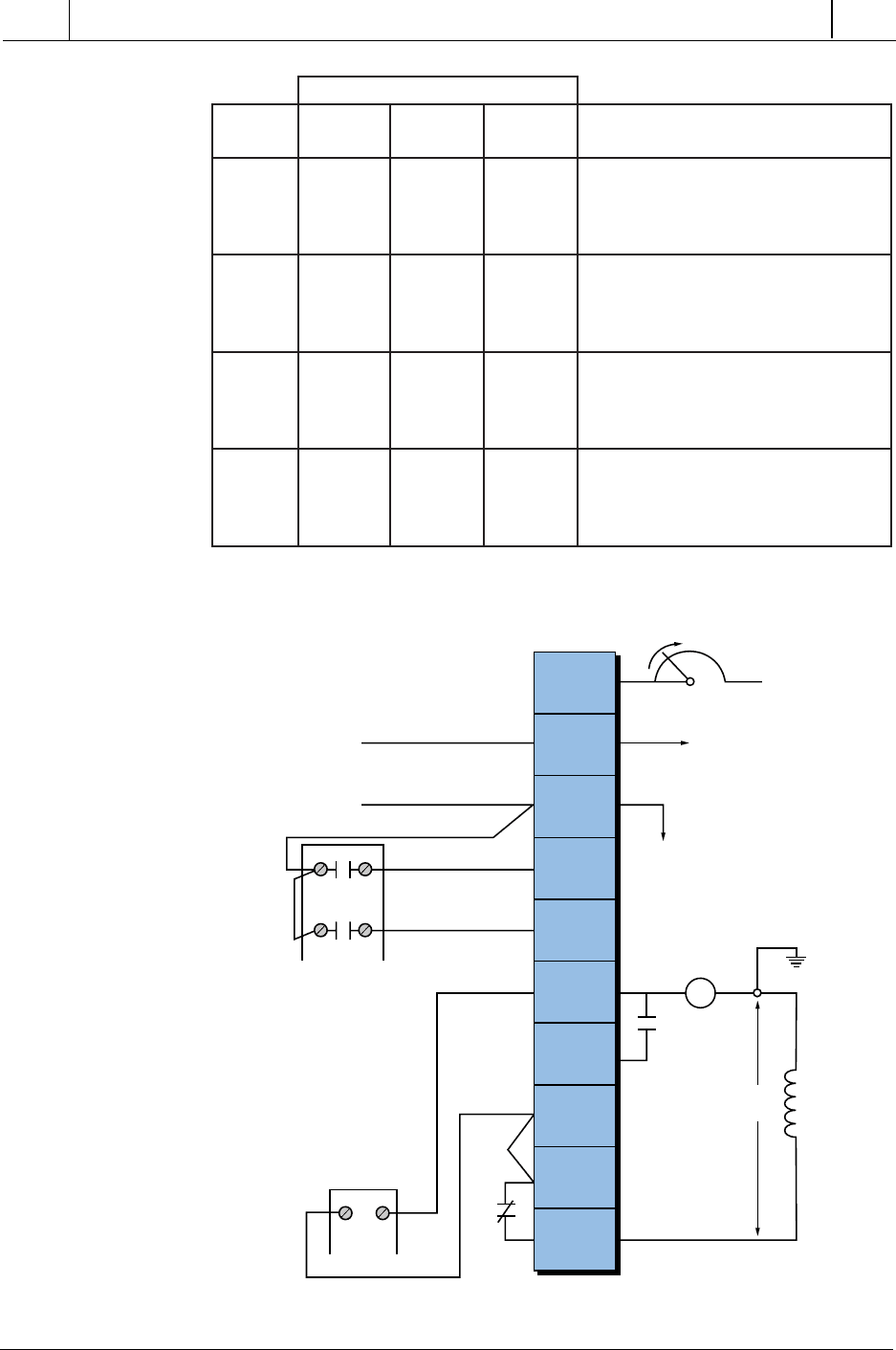
482
SECTION
3
PLC
Programming
Industrial Text & Video Company 1-800-752-8398
www.industrialtext.com
CHAPTER
11
System Programming
and Implementation
Figure 11-40. Connection diagram from the PLC to the VS drive’s terminal block.
Table 11-16. I/O address assignment.
sserddAO/I
eludoM
epyT kcaR puorG lanimreT noitpircseD
tupnI 0 0 0 tratS
0 0 1 potS
0 0 2 rotcelesesrever/drawroF
0 0 3 rotcelesgoj/nuR
tuptuO 0 3 0 )evirdmorf1L(elbaneevirD
CAV511 0 3 1
0 3 2
0 3 3
tuptuO 0 3 4 drawroF
tcatnoC 0 3 5 esreveR
0 3 6
0 3 7
golanA
0 7 0 CDV01–0ecnereferdeepsgolanA
tuptuO
0 7 1
0 7 2
0 7 3
1
2
3
4
5
6
7
8
9
10
Reverse
Spare
Spare
Forward
TB-1
To Speed Regulator
Common (Controller)
Drive
CR1
CR1
115
VAC
Chassis
Ground
Adjust
+12 V
Analog Output +
Analog Output –
Contact Output
L1 Out
115 VAC
Output
OLs
Output
30
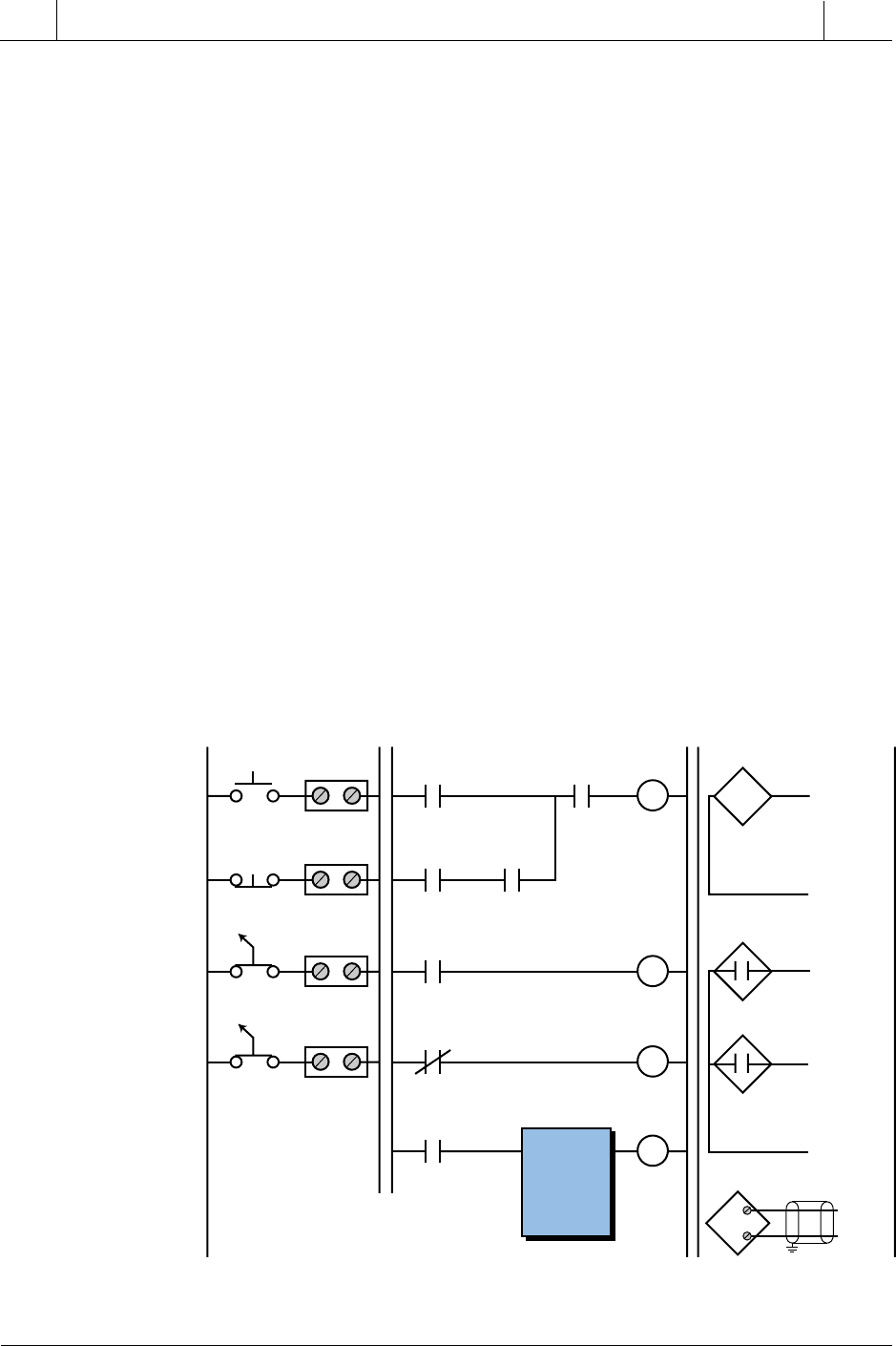
483
CHAPTER
11
System Programming
and Implementation
Industrial Text & Video Company 1-800-752-8398
www.industrialtext.com
SECTION
3
PLC
Programming
because the drive’s CR1 contact will not receive power from the output
module. This configuration, however, does not provide low-voltage protec-
tion, since the drive and motor will start immediately after the overloads cool
off and reclose. To have low-voltage protection, the auxiliary contact from
the drive, CR1 in terminal TB-1-7, must be used as an input in the PLC, so
that it seals the start/stop circuit.
Figure 11-41 shows the PLC ladder program that will replace the manual
operator station. The forward and reverse inputs are interlocked, so only one
of them can be ON at any given time (i.e., they are mutually exclusive). If the
jog setting is selected, the motor will run at the speed set by the analog output
when the start push button is depressed. The analog output connection simply
allows the output to be enabled when the drive starts. Register 4000 holds the
value in counts for the analog output to the drive. Internal 1000, which is used
in the block transfer, indicates the completion of the instruction.
Sometimes, a VS drive requires the ability to run under automatic or manual
control (AUTO/MAN). Several additional hardwired connections must be
made to implement this dual control. The simplest and least expensive way
to do this is with a selector switch (e.g., a four-pole, single-throw, single-
break selector switch). With this switch, the user can select either the
automatic or manual option. Figure 11-42 illustrates this connection. Note
Figure 11-41. PLC implementation of the VS drive.
L1 L1 L2L2
Start PB1
000
Start
PB1
000
Stop
PB2
001
Drive
En
030
XFER OUT
PR 4000
Slot 7
Rack 0
Length 1
Fwd* Rev
SEL1
002
Fwd
SEL1
002
Fwd
034
Drive En
030
Done
1000
Run* Jog
SEL2
003
Rev
SEL1
002
Rev
035
Stop PB2 001
Run/Jog
003
Drive En
030
030
TB-1-6
TB-1-8
034
035
TB-1-4
TB-1-5
TB-1-3
TB1-2
TB1-3
070
A
+
–
*Selector switch is logic 1 (closed)
in Fwd/Run position and logic 0
(open) in Rev/Jog position
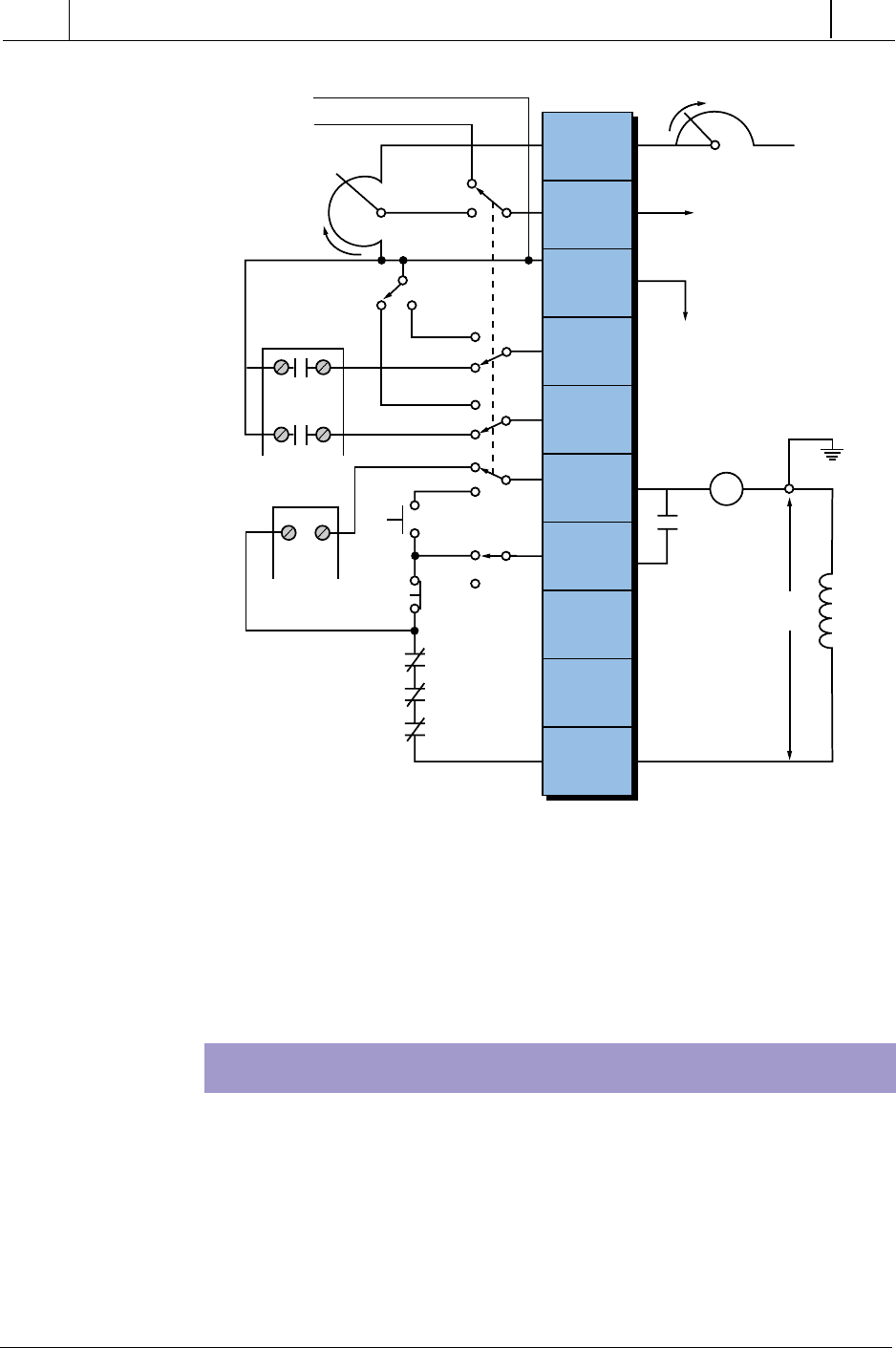
484
SECTION
3
PLC
Programming
Industrial Text & Video Company 1-800-752-8398
www.industrialtext.com
CHAPTER
11
System Programming
and Implementation
that the start, stop, run/jog, potentiometer, and forward/reverse field devices
shown are from the operator station. These devices are connected to the PLC
interface under the same names that are used in the control program (refer to
Figure 11-41). If the AUTO/MAN switch is set to automatic, the PLC will
control the drive; if the switch is set to manual, the manual station will
control the drive.
CONTINUOUS BOTTLE-FILLING CONTROL
Figure 11-42. VS drive with AUTO/MAN capability.
In this example (see Figure 11-43), we will implement a control program that
detects the position of a bottle via a limit switch, waits 0.5 seconds, and then
fills the bottle until a photosensor detects a filled condition. After the bottle
is filled, the control program will wait 0.7 seconds before moving to the next
bottle. The program will include start and stop circuits for the outfeed motor
and the start of the process. Table 11-17 shows the I/O address assignment,
while Tables 11-18 and 11-19 present the internal and register assignments,
respectively. These assignments include the start and stop process signals.
Start
Stop
1
2
3
4
5
6
7
8
9
10
Run
Jog
ForwardReverse
Reverse
Spare
Spare
Forward
TB-1
To Speed Regulator
Common (Controller)
Field Drive
OL
OL
OL
CR1
CR1
115
VAC
Chassis
Ground
Adjust
+12 V
Auto
Auto
Manual
Manual
Speed
Manual
Manual
Manual
–Analog Output
+Analog Output
Auto
Auto
Contact
Output
L1 Out
115 VAC
Output
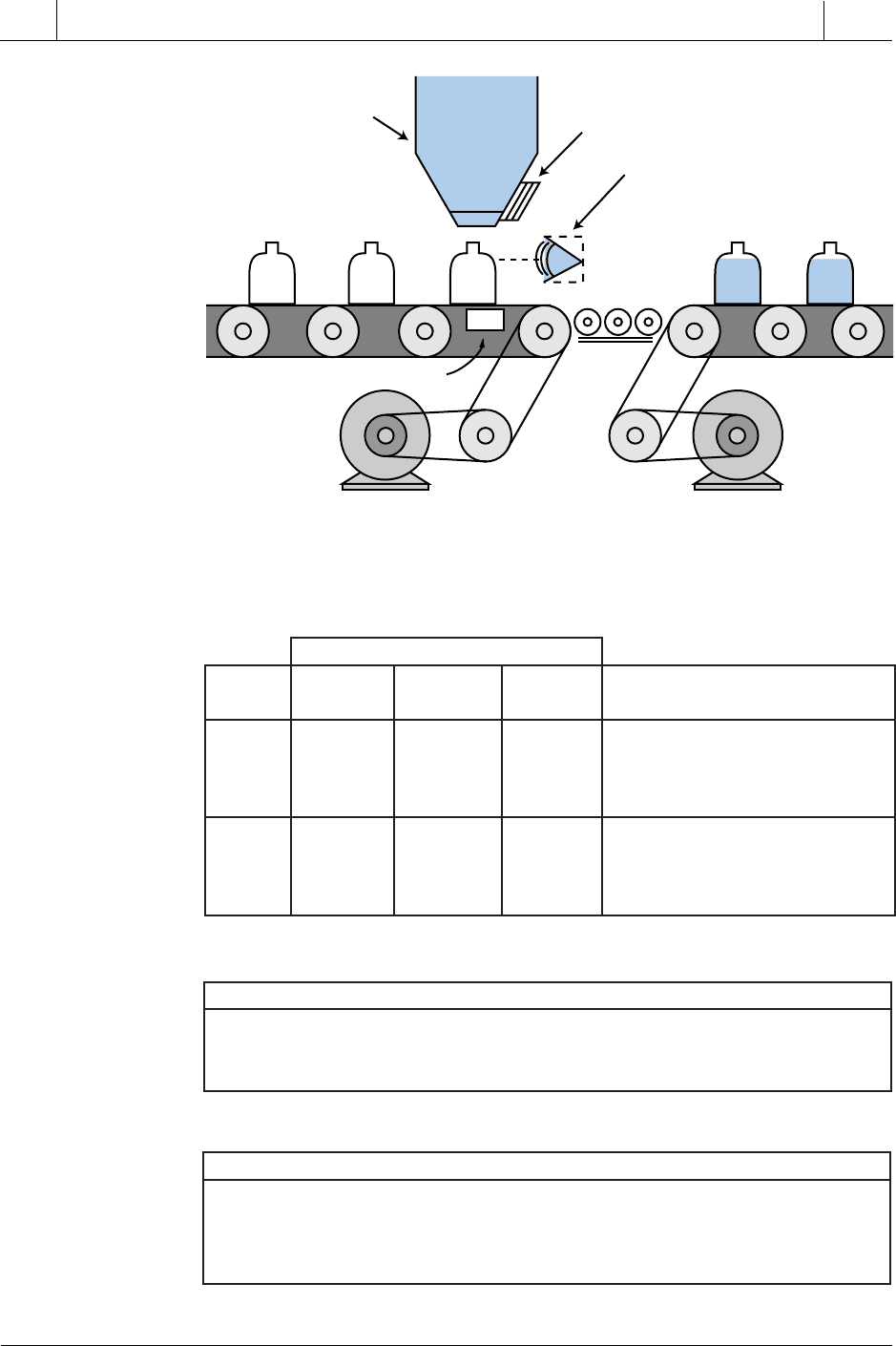
485
CHAPTER
11
System Programming
and Implementation
Industrial Text & Video Company 1-800-752-8398
www.industrialtext.com
SECTION
3
PLC
Programming
Table 11-18. Internal output assignment.
Table 11-19. Register assignment.
Figure 11-43. Bottle-filling system.
Table 11-17. I/O address assignment.
eciveDlanretnInoitpircseD
remiT1001tcetednoitisopretfayaledces5.0rofremiT
remiT2001tcetedlevelretfayaledces7.0rofremiT
—30011Mrotomdeef,tuodemit,dellifelttoB
Limit Switch
LS
Fixed
Rollers
Outfeed Motor Drive
(Always ON During Process)
M2
Feed Motor
Drive
M1
Photoeye Detector
Perpendicular To Bottle
Filled Bottles
Solenoid Operated Control
Fluid
sserddAO/I
eludoM
epyT kcaR puorG lanimreT noitpircseD
tupnI 0 0 0 1BPssecorptratS
0 0 1 )CN(2BPssecorppotS
0 0 2 )tcetednoitisop(hctiwstimiL
0 0 3 )tcetedlevel(eyeotohP
tuptuO
0 3 0 1MrotomdeeF
0 3 1 )NOmetsys(2MrotomdeeftuO
0 3 2 lortnocdioneloS
0 3 3 —
retsigeR noitpircseD
0004
)1001(ces1.0esabemit,5eulavteserP
1004
1001rofeulavdetalumuccA
2004
)2001(ces1.0esabemit,7eulavteserP
3004 2001rofeulavdetalumuccA

486
SECTION
3
PLC
Programming
Industrial Text & Video Company 1-800-752-8398
www.industrialtext.com
CHAPTER
11
System Programming
and Implementation
Figure 11-44 illustrates the PLC ladder implementation of the bottle-filling
application. Once the start push button is pushed, the outfeed motor (output
031) will turn ON until the stop push button is pushed. The feed motor M1
will be energized once the system starts (M2 ON); it will stop when the limit
switch detects a correct bottle position. When the bottle is in position and
0.5 seconds have elapsed, the solenoid (032) will open the filling valve and
remain ON until the photoeye (PE) detects a proper level. The bottle will
remain in position for 0.7 seconds, then the energized internal 1003 will start
the feed motor. The feed motor will remain ON until the limit switch detects
another bottle.
Figure 11-44. PLC implementation of the bottle-filling application.
L1 L1 L2L2
Start PB1
Stop PB2
PB1
000
M2
031
Int3
1003
Bottle
Filled
1003
PB2
001
032
000
001
PE
003
LS
LS
002
M2
031
M1
030
M2
031
002
SOL1
031
LS
002
M2
031
TMR
1001
M2
030
M1
TMR
PR 4000
50
AR 4001
TB = 0.1
TMR
1001
PE
003
M2
031
SOL
032
TMR
1002
LS
002
M2
031
Bottle
Filled
1003
PE
003
M2
031
Bottle
Filled
1003
TMR
1002
TMR
PR 4000
70
AR 4001
TB = 0.1

487
CHAPTER
11
System Programming
and Implementation
Industrial Text & Video Company 1-800-752-8398
www.industrialtext.com
SECTION
3
PLC
Programming
LARGE RELAY SYSTEM MODERNIZATION
This example presents the modernization of a machine control system that
will be changed from hardwired relay logic to PLC programmed logic. The
field devices to be used will remain the same, with the exception of those that
the controller can implement (e.g., timers, control relays, interlocks, etc.).
The benefits of modernizing the control of this machine are:
• a more reliable control system
• less energy consumption
• less space required for the control panel
• a flexible system that can accommodate future expansion
Figure 11-45 illustrates the relay ladder diagram that presently controls the
logic sequence for this particular machine. For the sake of simplicity, the
diagram shows only part of the total relay ladder logic.
An initial review of the relay ladder diagram indicates that certain portions
of the logic should be left hardwired—lines 1, 2, and 3. This will keep all
emergency stop conditions independent of the controller. The hydraulic
pump motor (M1), which is energized only when the master start push button
is pushed (PB1), should also be left hardwired. Figure 11-46 illustrates these
hardwired elements. Note that the safety control relay (SCR) will provide
power to the rest of the system if M1 is operating properly and no emergency
push button is depressed. Furthermore, the PLC fault contact can be placed
in series with the emergency push buttons and also connected to a PLC failure
alarm. During proper operation, the PLC will energize the fault coil, thus
closing PLC Fault Contact 1 and opening PLC Fault Contact 2.
Continuing the example, we can now start assigning the real inputs and
outputs to the I/O assignment document. We will assign internal output
addresses to all control relays, as well as timers and interlocks from control
relays. Tables 11-20 and 11-21 present the assignment and description of the
inputs and outputs, as well as the internals. Note that inputs with multiple
contacts, such as LS4 and SS3, have only one connection to the controller.
Figure 11-47 shows the PLC program coding (hardwired relay translation)
for this example. This ladder program illustrates several special coding
techniques that must be used to implement the PLC logic. Among these
techniques are the software MCR function, instantaneous contacts from
timers, OFF-delay timers, and the separation of rungs with multiple outputs.
An MCR internal output, specified through the program software, performs
a function similar to a hardwired MCR. Referring to the relay logic diagram
in Figure 11-45, if the MCR is energized, its contacts will close, allowing
power to flow to the rest of the system. In the PLC software, the internal MCR
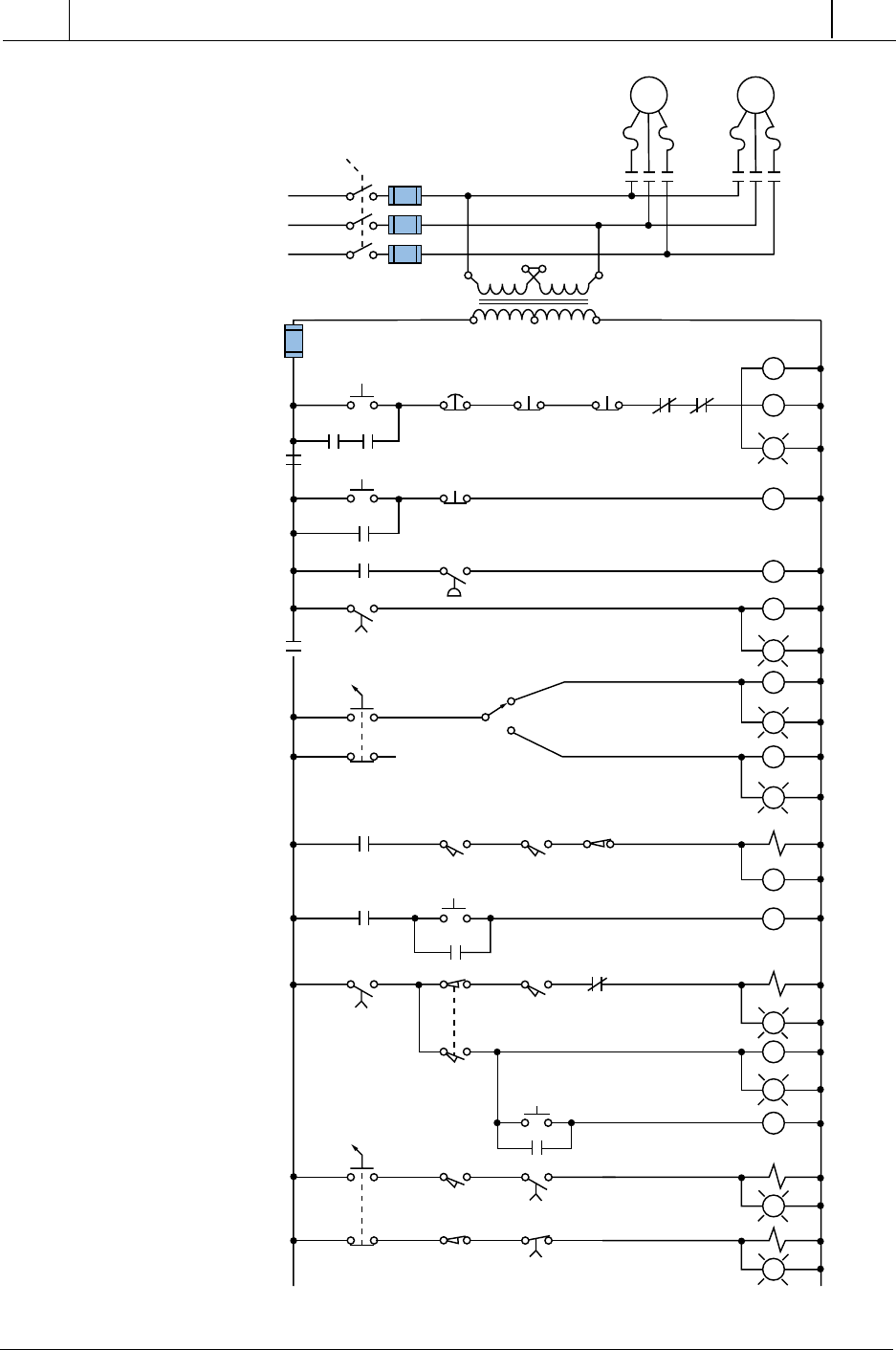
488
SECTION
3
PLC
Programming
Industrial Text & Video Company 1-800-752-8398
www.industrialtext.com
CHAPTER
11
System Programming
and Implementation
Figure 11-45. Electromechanical relay diagram.
PB1
Master
Start
PB2
Master
Stop
PB5 Setup
PB6 Reset
PB3
Emergency
Stop 1
PB4
Emergency
Stop 2
M1
SCR1-1
SCR1-2
MCR
OL1 OL1
4FU
OL1OL1
1M 1M 1M
M1
OL2OL2
2M 2M 2M
M2
1FU
2FU
3FU
L1
L2
L3
H1
X1 X2 X3
H2 H3
H4
L1 L2
M1
SCR1
CR1
TDR1
CR2
CR3
MCR
PL1
PL2
CR1-1
TDR2-1
CR1-2
CR2-1 LS1 LS2 LS3
SOL1
CR4
TDR1
PS1
Hyd
Pres
R
PL4
R
PL3
R
G
SEL1
SEL2
SS2
SS1 Enable
Off On
1
2
13
14
3
4
5
6
TDR2
CR4-1
PB6
Start
Cycle
15
7
8
9
10
11
23
25
26
24
12
TDR2-2 LS4 LS5 CR3-1
SOL2
16
18
19
20
21
22
17
LS4
PB7
Unload
PL5
G
SOL3
PL7
G
PL6
G
M2
TDR3
TDR3-1
Main Back-Up
SS3
LS6 TDR3-2
SOL4
PL8
G
LS7 TDR3-3
